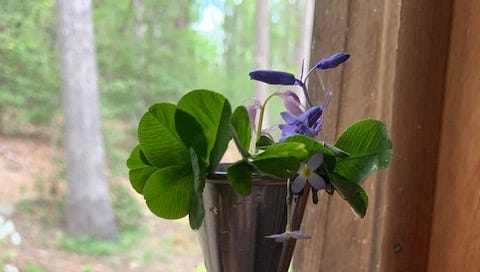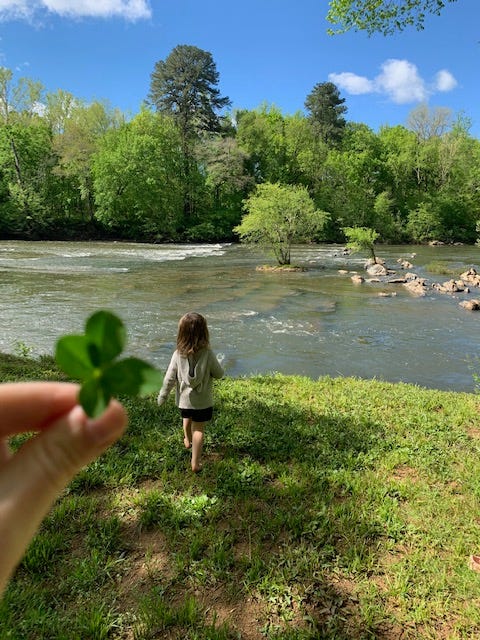(a book of spells, a clutch of four-leaf clovers)
Last year, during a visit to California—a state devastated by the worst wildfires in recorded history—then-President Donald Trump told officials, “It’ll start getting cooler. You just watch.”
Most grade-school children know the difference between climate and weather; whether the president knew, and didn’t care, or just never paid attention in science class, is immaterial to his choices, which include (but are not limited to): exiting the Paris climate agreement, rolling back offshore drilling rules, greenlighting the disastrous Keystone XL pipeline, and signing orders to increase the logging of public lands.
A lot of people accused Trump, when he was president, of the phenomenon of magical thinking—the idea that unrelated events (like, a cooler day or a snowy winter means climate change is false or if I say “Covid will be gone by Easter” it will) are somehow connected, or that acting on superstition can change reality. Magical thinking leans on what we want to see, like cooler weather or a return to normalcy, and blocks out the harsh realities, like historic wildfires and sound advice from scientists and doctors.
I think Trump’s attitude toward the environment is better described as golf course thinking—the idea that nature can be shaped in a way that is visually pleasing (to some), under control, and representative of a certain kind of old white man’s idea of cleanliness. Most golf courses, where Trump spent a lot of his presidency, are terrible for the environment, but they appeared to represent, for Trump and probably for a lot of other decision-makers in his cabinet, a visual ideal of the great outdoors: expanses of perfectly green grass, pools of chemically-treated water, and when you get too hot, an air-conditioned clubhouse. Golf course thinking says “I am enjoying myself and my vistas are pleasing to me, who cares what happens to anyone else.”
When Trump attempted to speak positively about the environment, he tended to use generalities that evoked product advertising: “crystal clear water” brought to mind swimming pools or bottled water; his “really immaculate air” made me think of—well, I don’t know what to do with that one. Maybe that’s what the air is like inside tanning beds?
A lot of people won’t say his name anymore, and I think that’s a fine choice. I have felt relief every single day since he was soundly defeated in last year’s election, and I am happy that President Biden has returned us to the Paris agreement and is working on restoring the protective powers of the EPA. But the truth is Trump’s presidency lasted for ages three to seven for Beatrice, and for the first two-plus years of Harriet’s life. It was a disastrously consequential presidency that will affect children across the world for the rest of their lives, both in the deliberately malevolent acts of his administration and in the climate crisis that worsened over his watch.
Obviously, Trump’s form of magical thinking—whatever you want to call it—won’t save us. But if you were to say “magical thinking” to Beatrice, she’d have another definition for you: imagining what is possible.
The other day, Beatrice and Harriet and I enjoyed a picnic next to the Haw River. The Haw has a long history of pollution tied to industry and environmentally reckless farming practices; my neighbor, who once worked in the textile mills in Saxapahaw, remembers when the Haw’s water used to run different colors, depending on what the dye mill released.
I’ve lived near the Haw for almost fifteen years, and I have noticed signs of recovery in the increase in small animals I see in the creeks and shallow spots—crawdads, salamander larvae, tadpoles and frogs and turtles. It looks beautiful: there is even a massive bald eagle nest, right across from our neighborhood river access.
(Out-of-focus clover, in-focus Harriet. The large pine across the river houses an eagle nest.)
But recently news about PFAS, a group of man-made chemicals used to coat nonstick pans, create water repellent fabrics, and in fire suppression, has revealed unseen dangers in our river. PFAS are known carcinogens, causing birth defects and low birth weight, elevating the risk of thyroid disease, and increasing blood cholesterol levels of people exposed. PFAS exposure can also mute the body’s response to vaccines, and has been linked to more severe COVID outcomes.
Because of the industrial pollution upriver, the nearby town of Pittsboro (which gets its water from the Haw) has among the worst, most dangerous drinking water in the United States. The levels of PFAs in Pittsboro’s water are eighty times what they should be. And it’s not just Pittsboro—the Environmental Working Group estimates that PFAS is detectable in all major water supplies in the United States. Most Americans have some level of PFAS in our blood.
We have well water, but we do spend a lot of time in the Haw: wading, swimming, boating, and riding big rafts that are probably, now that I think of it, coated with PFAS. I thought it was best to re-emphasize what I’ve always said to Bea: don’t drink the river water or open your mouth when you’re swimming! Don’t duck your head under the water! Etcetera.
Of course she asked why. And I told her about PFAS, how environmental regulations have allowed industry to produce and release these “forever chemicals” that we know are harmful. Even though the river looks beautiful and clean, I explained, its water has chemicals that are dangerous to drink, dangerous for animals too (frogs included).
Bea looked at the river—it was a gorgeous, sunny day—and I could see the gears turning in her mind. I wondered if I’d said too much, if she’d one day tell a therapist or a newsletter “I used to love the river near my house and then my mom told me how polluted it was, spoiling my childhood forever.”
She turned back to me and her sister.
“If I had the power, I’d turn myself invisible and teleport to the book of rules,” she said. “I’d cross out the bad rules and write, ‘No polluting the river!’”
Then she got up and did some cartwheels.
I like Beatrice’s, and most children’s, version of magical thinking, because unlike most adults’ (and unlike golf course thinking) it is about taking radical action. The most radical climate activists today are children, or started their activism as children. They are not afraid to call out the cowardice and selfishness of adults, and they know that thinking big is the only thing that will save us.
Let’s cross out the bad rules. Let’s think magically (more on that on Tuesday).
In the meantime, please spread the word about the FTT so we can talk more about how to talk and listen to kids about nature, climate change, and the future.
Not subscribed? It’s free!
Bea and I are excited about Tuesday’s activity. We hope to see you then.






The golf course analogy is perfect!